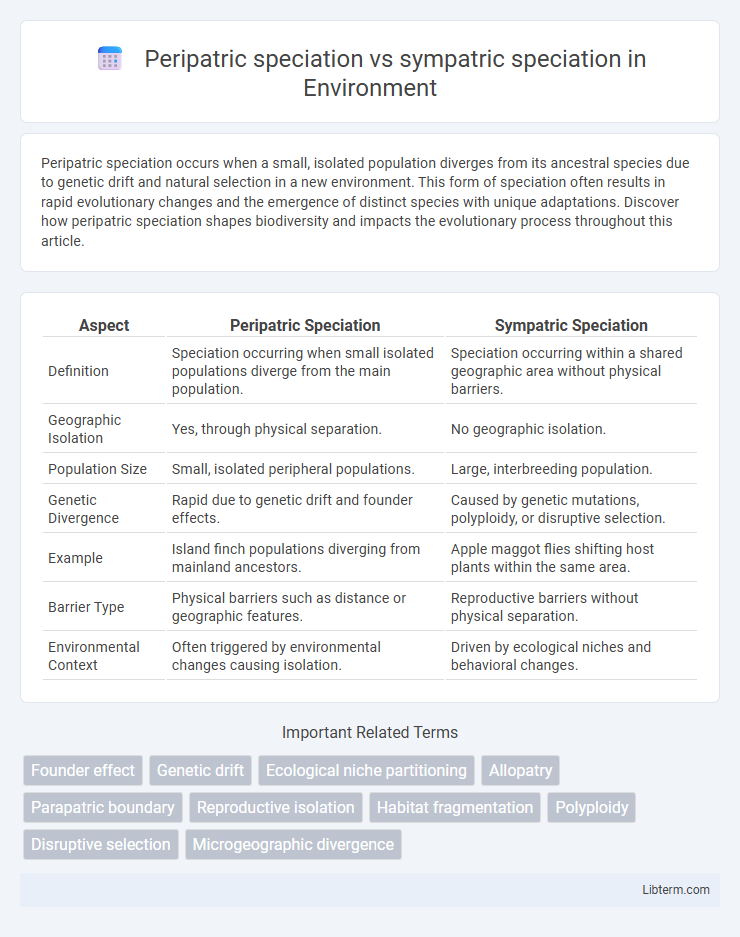Peripatric speciation occurs when a small, isolated population diverges from its ancestral species due to genetic drift and natural selection in a new environment. This form of speciation often results in rapid evolutionary changes and the emergence of distinct species with unique adaptations. Discover how peripatric speciation shapes biodiversity and impacts the evolutionary process throughout this article.
Table of Comparison
| Aspect | Peripatric Speciation | Sympatric Speciation |
|---|---|---|
| Definition | Speciation occurring when small isolated populations diverge from the main population. | Speciation occurring within a shared geographic area without physical barriers. |
| Geographic Isolation | Yes, through physical separation. | No geographic isolation. |
| Population Size | Small, isolated peripheral populations. | Large, interbreeding population. |
| Genetic Divergence | Rapid due to genetic drift and founder effects. | Caused by genetic mutations, polyploidy, or disruptive selection. |
| Example | Island finch populations diverging from mainland ancestors. | Apple maggot flies shifting host plants within the same area. |
| Barrier Type | Physical barriers such as distance or geographic features. | Reproductive barriers without physical separation. |
| Environmental Context | Often triggered by environmental changes causing isolation. | Driven by ecological niches and behavioral changes. |
Introduction to Speciation
Peripatric speciation occurs when a small population becomes isolated at the edge of a larger population's range, leading to genetic divergence due to limited gene flow and genetic drift. Sympatric speciation happens within a single geographic area through mechanisms like polyploidy, sexual selection, or ecological niche differentiation that reduce gene flow within the population. Both processes contribute to the formation of new species by fostering reproductive isolation and genetic diversification.
Defining Peripatric Speciation
Peripatric speciation occurs when a small population becomes isolated at the edge of a larger population's range, leading to genetic divergence due to limited gene flow and strong selective pressures. This mode of speciation is characterized by the founder effect, where the isolated group's genetic makeup differs significantly from the original population. Unlike sympatric speciation, which happens within a shared habitat, peripatric speciation relies heavily on geographic isolation and population size to drive evolutionary change.
Defining Sympatric Speciation
Sympatric speciation occurs when new species evolve from a single ancestral population while inhabiting the same geographic region, driven primarily by genetic divergence and reproductive isolation mechanisms rather than physical barriers. This process often involves factors such as polyploidy, sexual selection, or ecological niche differentiation that prevent gene flow within overlapping populations. In contrast, peripatric speciation relies on small peripheral populations becoming isolated, emphasizing geographic separation coupled with genetic drift and selection pressures.
Key Differences Between Peripatric and Sympatric Speciation
Peripatric speciation occurs when a small population becomes isolated at the edge of a larger population, leading to genetic divergence due to limited gene flow and genetic drift. Sympatric speciation takes place within a single population in the same geographic area, often driven by ecological niche differentiation or polyploidy in plants. The key difference lies in geographic isolation for peripatric speciation versus genetic or ecological isolation without physical barriers in sympatric speciation.
Geographic Context in Speciation
Peripatric speciation occurs when a small population becomes geographically isolated at the edge of a larger population, leading to reproductive isolation and divergence due to limited gene flow and distinct environmental pressures. Sympatric speciation takes place without physical barriers, where reproductive isolation arises within a single geographic area through genetic, behavioral, or ecological factors such as polyploidy or niche differentiation. The key geographic distinction lies in peripatric speciation requiring spatial separation, while sympatric speciation evolves despite overlapping habitats.
Mechanisms Driving Peripatric Speciation
Peripatric speciation is driven by the isolation of small peripheral populations through geographic barriers, leading to genetic drift and founder effects that rapidly fix novel alleles. Reduced gene flow in these isolated populations amplifies divergence via selection pressures unique to the peripheral environment, promoting reproductive isolation. In contrast to sympatric speciation, which relies on reproductive barriers arising within a shared habitat, peripatric speciation emphasizes allopatric mechanisms combined with demographic stochasticity.
Mechanisms Driving Sympatric Speciation
Sympatric speciation occurs when new species evolve from a single ancestral population while inhabiting the same geographic region, driven primarily by mechanisms such as polyploidy, disruptive selection, and behavioral isolation. Polyploidy, especially common in plants, results in instant reproductive isolation due to chromosome number changes. Disruptive selection promotes divergence by favoring extreme phenotypes over intermediate forms, while behavioral isolation arises through mating preferences that prevent gene flow within a shared environment.
Examples of Peripatric and Sympatric Speciation
Peripatric speciation occurs when a small population becomes isolated at the edge of a larger one, as seen in the evolution of the polar bear from brown bear ancestors during geographic isolation around the Arctic. Sympatric speciation happens within the same geographic area, exemplified by cichlid fish in African rift lakes where new species arise through niche differentiation and sexual selection without physical barriers. These examples highlight how environmental context and reproductive isolation mechanisms drive species divergence in peripatric versus sympatric scenarios.
Evolutionary Significance and Implications
Peripatric speciation, driven by geographic isolation of small populations, promotes rapid genetic divergence through founder effects and genetic drift, facilitating adaptive radiation and biodiversity expansion. Sympatric speciation occurs within overlapping ranges via ecological niche differentiation or polyploidy, highlighting mechanisms of reproductive isolation without physical barriers, crucial for understanding speciation in complex ecosystems. Both modes underscore distinct evolutionary pathways enhancing species diversification and adaptive potential in varying environmental contexts.
Current Debates and Future Research Directions
Current debates in peripatric versus sympatric speciation revolve around the relative roles of geographic isolation and genetic divergence in driving reproductive barriers. Researchers are investigating genomic signatures and ecological factors that distinguish the two modes, with emphasis on gene flow levels and adaptive radiation in isolated versus overlapping populations. Future research directions prioritize integrating high-resolution genomic data and ecological modeling to clarify speciation mechanisms and the evolutionary significance of rare sympatric events.
Peripatric speciation Infographic

 libterm.com
libterm.com